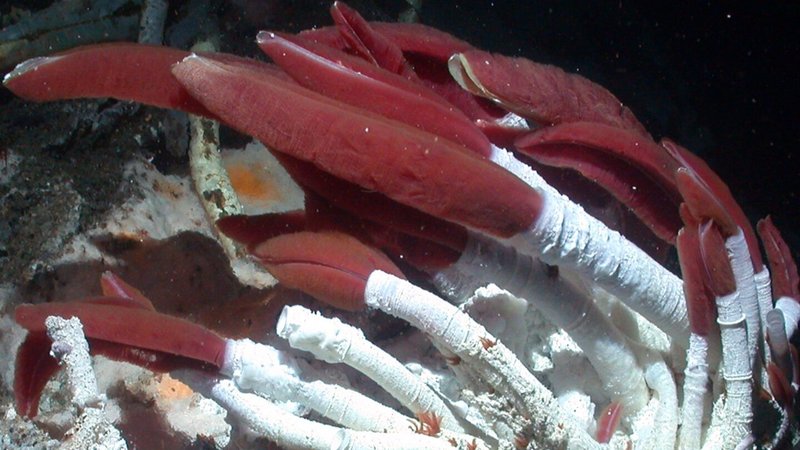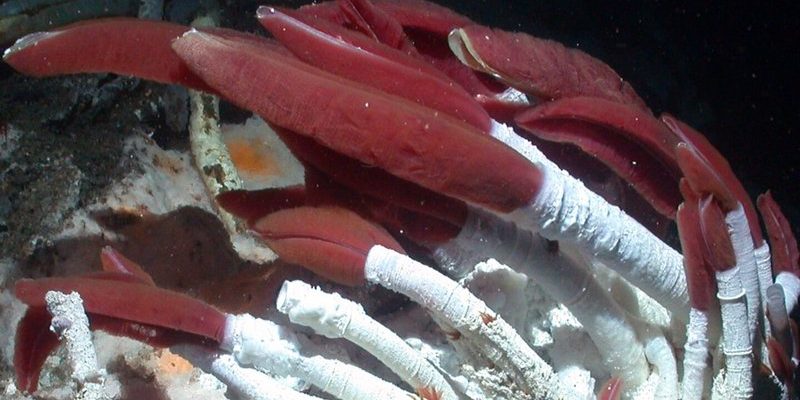
So, what’s so special about these tube worms? Well, they have a life cycle and behavior that are as remarkable as their habitat. Understanding their journey from larva to adult and how they interact with their environment can give us clues about life in the deep sea and the ecosystems we’re only just beginning to discover. Let’s dive deeper into the life of the Riftia pachyptila, and see how it navigates its unique world.
The Birth: Larval Stage of Riftia Pachyptila
The life cycle of the Riftia pachyptila kicks off in a rather intriguing way. After mating, female tube worms release tiny larvae into the surrounding water, where they begin their journey. This larval stage is short-lived and crucial for the survival of the species. Think of it like a young bird leaving the nest for the first time; it’s a critical moment filled with risk and opportunity.
Once the larvae are released, they drift in the currents of the deep sea for about a week. During this time, they are vulnerable to a host of predators. However, here’s the interesting part: these larvae are not just aimlessly floating around. They’re equipped to sense the hydrothermal vents, which are their future homes. Guided by chemical signals in the water, they swim toward these nutrient-rich oases, where they’ll settle and begin their transformation.
Upon reaching a hydrothermal vent, the larvae attach themselves to a solid surface, often a rock or the vent chimney. This is where they undergo a significant change—a metamorphosis that leads them to become the impressive tube worms we recognize.
Settling Down: The Juvenile Stage
After attaching to a surface, the larvae begin developing into juvenile Riftia pachyptila. This stage is all about growth and adaptation. Initially, these young worms are quite small, measuring only a few centimeters. They start building their protective tubes, which play a critical role in their survival. Imagine living in a cozy home, shielded from harsh conditions; that’s precisely what these tubes do.
As they grow, the juvenile worms start to establish a symbiotic relationship with bacteria. This isn’t just any relationship—it’s a partnership that benefits both parties immensely. The Riftia pachyptila provides the bacteria with a safe space to live, while the bacteria convert the vent’s chemicals, like hydrogen sulfide, into energy through a process called chemosynthesis. It’s like having your very own kitchen stocked with nutritious food, all thanks to a clever roommate!
These juvenile tube worms can grow surprisingly fast, often reaching lengths of up to 1 meter in just a few months. It’s an incredible growth rate, considering the extreme conditions around them, including high pressure and temperatures that can exceed 350 degrees Celsius.
Adulthood: The Life of a Mature Riftia Pachyptila
Once they reach maturity, Riftia pachyptila becomes a stunning sight. They can grow to impressive lengths, sometimes exceeding 3 meters! Their vibrant, feathery plumes, which stick out of their tubes, serve multiple purposes. First, they capture energy from the water, helping to support the bacteria inside the worm. Secondly, they aid in respiration by absorbing oxygen from the hydrothermal vent waters.
In adulthood, these tube worms don’t just sit idly; they are surprisingly active. They can reposition their plumes for optimal nutrient absorption, showcasing their adaptability to changing conditions. They have a fascinating behavior pattern that includes *swaying* and *shifting* their plumes to maximize energy intake. It’s like they’re dancing in the deep sea, making the most of their environment.
Moreover, the mature Riftia pachyptila can live for decades, often forming large colonies near hydrothermal vents. These colonies contribute to the unique biodiversity of vent ecosystems, providing homes and resources for various other marine life, like crabs and fish.
Symbiosis: The Importance of Bacteria
The relationship between Riftia pachyptila and their symbiotic bacteria is a game-changer for understanding life in extreme environments. These bacteria are not just hitching a ride; they are essential for the survival of the tube worms. As mentioned earlier, Riftia pachyptila relies on chemosynthesis, where bacteria convert chemicals from the vent into energy. This process is somewhat akin to plants using sunlight to create food.
By engaging in this symbiotic relationship, Riftia pachyptila can thrive in an environment devoid of sunlight, where most life forms would struggle to exist. This partnership is important not just for the tube worms but also for the entire vent ecosystem. It showcases how life can adapt and flourish in the most challenging conditions.
Moreover, the study of this relationship offers scientists insights into potential life forms we might find on other planets. If life can thrive in the deep sea, could it exist in the harsh conditions of places like Europa or Mars? It’s a thought-provoking consideration.
Reproduction: Continuing the Cycle
When it comes to reproduction, the Riftia pachyptila has its own unique methods. As these creatures reach maturity, they produce gametes and participate in external fertilization. During spawning events, they release their eggs and sperm into the water, where fertilization occurs. This is quite similar to other marine organisms, but it’s all about timing and environmental factors.
The timing of spawning is often synchronized with environmental cues, like changes in water temperature and chemical composition. This synchronization increases the chances of successful fertilization, as many tube worms release their gametes simultaneously. Picture a grand ocean ballet, with all the dancers moving in perfect harmony to ensure the next generation has the best chance of survival.
Once the larvae are born and released into the ocean, the whole cycle starts anew. It’s a beautiful and complex process that underscores the resilience of life in one of our planet’s most extreme environments.
Behavior: Daily Life of the Riftia Pachyptila
You might be curious about what daily life looks like for the Riftia pachyptila. These tube worms are surprisingly active, despite their seemingly passive lifestyle. They feed primarily on the nutrients produced by their symbiotic bacteria. This means they spend a lot of time adjusting their plumes to capture the right amount of chemicals from the water. Think of them as diligent gardeners tending to their plants, ensuring they get enough sunlight—or in this case, nutrients.
Despite being stationary, they do have a few behaviors that might surprise you. For instance, they can react to their environment by retracting their plumes if something threatens them. This behavior is essential for their survival, especially since they live in a habitat where predators, like certain types of crabs, lurk nearby.
In addition, they can also adjust their tube depth. If conditions change, like a shift in temperature or water chemistry, they might move deeper into their tubes for protection. It’s a fascinating blend of simplicity and complexity all rolled into one.
The life cycle of the Riftia pachyptila is nothing short of remarkable. From its larval stage floating in the ocean to its role as a mature tube worm living in one of the harshest environments on Earth, it showcases the resilience and adaptability of life. The complex relationships it forms with bacteria highlight the intricacies of ecosystems, especially in extreme conditions.
As we continue to explore the depths of our oceans, learning more about creatures like the Riftia pachyptila, we gain insights not just into their lives but also into the broader implications for biology, ecology, and even the possibilities of life beyond our planet. So next time you think about the ocean, remember the hidden wonders like the Riftia pachyptila that are silently thriving in the darkness, reminding us that life finds a way, no matter the odds.

